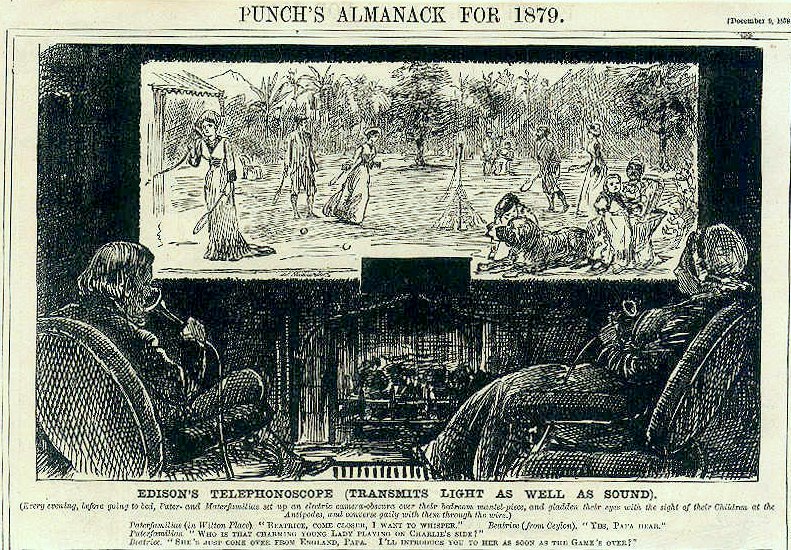They& #39;re on a video call
------------------
| (\__/) | (\__/) |
| (•ㅅ•) | (•ㅅ•) |
| / づ | / \ |
-------------------
| (\__/) | (\__/) |
| (ᵔㅅᵔ) | (•ㅅ•) |
| / \ | / づ |
-------------------
------------------
| (\__/) | (\__/) |
| (•ㅅ•) | (•ㅅ•) |
| / づ | / \ |
-------------------
| (\__/) | (\__/) |
| (ᵔㅅᵔ) | (•ㅅ•) |
| / \ | / づ |
-------------------
Like our little pals here, most of us are using video calls to have meetings and stay in touch with friends and family at the moment.
We thought we& #39;d have a look into the history of the technology that& #39;s making our lives a little easier.
We thought we& #39;d have a look into the history of the technology that& #39;s making our lives a little easier.
Video calling might seem like a fairly new technology, but the idea has been around since the 1870s.
Not long after Alexander Graham Bell patented the telephone, the concept of a videophone and television, called a telephonoscope, began appearing in periodicals at the time.
Not long after Alexander Graham Bell patented the telephone, the concept of a videophone and television, called a telephonoscope, began appearing in periodicals at the time.
Reports of & #39;amazing advances& #39; in videotelephone technology began to appear in the 1880s, however they were quickly proven false, sometimes by Graham Bell himself.
Alexander Graham Bell did believe the technology was possible, even saying "the day will come when the man at the telephone will be able to see the distant person to whom he is speaking"
It wasn& #39;t until the early 20th century, when advances in television were being made by John Logie Baird in the UK and AT&T in the United States, that the idea of video calling began to seem like more of a reality.
In 1927, while working at AT&T& #39;s Bell Labs, Herbert E. Ives created a two-way television-telephone system called the ikonophone.
AT&T were committed to making advances in both videotelephony and television and spent years on researching and developing these areas.
AT&T were committed to making advances in both videotelephony and television and spent years on researching and developing these areas.
The first public videophone service was introduced in Germany in the 1930s. It involved two closed-circuit televisions, one at a post office in Berlin and one in Leipzig, connected by 100 miles (160km) of special cable. The first call was made on 1 March 1936.
By the 1950s, AT&T had developed a way of sending still images on their Picturephone. The images were taken with a compact camera and transmitted every two seconds using regular phone lines and displayed at the other end on a small television unit.
On 20 April 1964 the first transcontinental videocall was made using the Picturephone.
William L. Laurence, who was at the New York Worlds Fair, spoke to Anaheim Bulletin Managing Editor Donald Shaffer at Disneyland in California.
William L. Laurence, who was at the New York Worlds Fair, spoke to Anaheim Bulletin Managing Editor Donald Shaffer at Disneyland in California.
AT&T went on to develop the first video conferencing system with the introduction of the Picturephone Mod II.
The first video conferencing call was made on 30 June 1970 by the Pittsburgh Mayor, Peter Flaherty, and Alcoa CEO John Harper.
The first video conferencing call was made on 30 June 1970 by the Pittsburgh Mayor, Peter Flaherty, and Alcoa CEO John Harper.
While none of the early video conferencing technology was a big commercial success, companies kept working to create new ways of video calling.
In 1985, Mitsubishi introduced the Lumaphone, the first commercially available mobile videophone.
In 1985, Mitsubishi introduced the Lumaphone, the first commercially available mobile videophone.
In the early 1990s the rise of home computers saw video calling technology go digital.
In 1991, IBM introduced PicTel, a PC-based video conferencing system and in 1992 Apple brought in CU-SeeMe.
In 1991, IBM introduced PicTel, a PC-based video conferencing system and in 1992 Apple brought in CU-SeeMe.
In 1994, Apple added sound to CU-SeeMe, making it the first real commercially-viable video conferencing technology.
Nowadays we& #39;ve got lots of great options for keeping in touch with our friends, family and colleagues and we are very grateful for it right now.
Hopefully this thread has given you some good facts you can use in your next Teams/Zoom/Skype/FaceTime/WhatsApp/Facebook video call...
Hopefully this thread has given you some good facts you can use in your next Teams/Zoom/Skype/FaceTime/WhatsApp/Facebook video call...

 Read on Twitter
Read on Twitter


